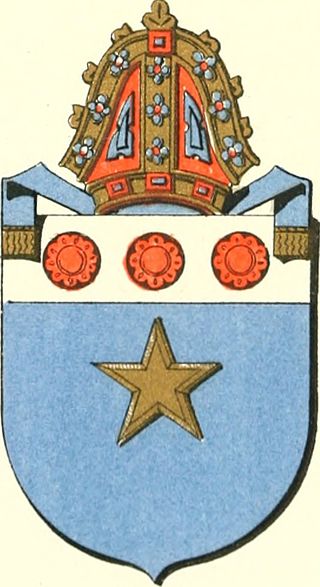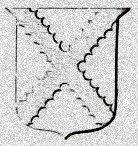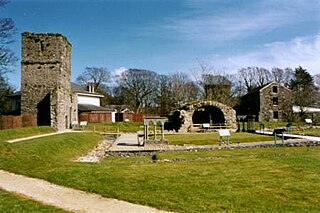Related Research Articles
Donald Campbell was a 16th-century Scottish noble and churchman. He was the son of Archibald Campbell, 2nd Earl of Argyll and Elizabeth Stewart, daughter of John Stewart, 1st Earl of Lennox. From 1522, he was a student of St Salvator's College, at the University of St Andrews. After graduation, he became a cleric in his home diocese, the diocese of Argyll.
Robert Crichton was a 16th-century Scottish Catholic cleric.
Walter was Chamberlain of Alan, Lord of Galloway and later Bishop of Galloway. As Alan's chamberlain, he succeeded Bishop John after the latter's death, in 1209. His election coincided with the northern expedition of King John of England to secure the submission of King William of Scotland; Alan enjoyed friendly relations with the English king, the latter wishing to make use of Alan's manpower and naval resources, and so the election of Walter may have had something to do with King John.
John of Whithorn was the medieval Bishop of Galloway. His first appearance as bishop-elect is at the coronation of Richard, Cœur de Lion as King of the English at Westminster Abbey on 3 September 1189. He was consecrated at Pipewell Abbey, Northamptonshire, on Sunday 17 September 1189.

Henry was a 13th-century Augustinian abbot and bishop, most notable for holding the positions of Abbot of Holyrood and Bishop of Galloway.
Thomas de Kirkcudbright, also known as Thomas de Dalton [de Daltoun], was a medieval prelate from the Kingdom of Scotland. He was apparently a nutritus, or foster son, of Robert V de Brus, Lord of Annandale, and seems to have been closely linked in some way to Adam de Kirkcudbright, the man who held the church of Dalton in Annandale. He was likely a native Galwegian or perhaps a native of Annandale.

Gilbert was a 13th-century Cistercian monk, abbot and bishop. His first appearance in the sources occurs under the year 1233, for which year the Chronicle of Melrose reported that "Sir Gilbert, the abbot of Glenluce, resigned his office, in the chapter of Melrose; and there he made his profession". It is not clear why Gilbert really did resign the position of Abbot of Glenluce, head of Glenluce Abbey in Galloway, in order to become a mere brother at Melrose Abbey; nor is it clear for how long Gilbert had been abbot, though his latest known predecessor is attested last on 27 May 1222. After going to there, Gilbert became the Master of the Novices at Melrose.
Odo Ydonc was a 13th-century Premonstratensian prelate. The first recorded appearance of Odo was when he witnessed a charter by Donnchadh, Earl of Carrick, on 21 July 1225. In this document he is already Abbot of Dercongal, incidentally the first Abbot of Dercongal to appear on record.

David Arnot was a Scottish prelate of the Catholic Church. He was the Bishop of Galloway (Scotland) from 1509 to 1526. He was from the Arnot family of Arnot, Fife.
Henry Wemyss was a prelate from the 16th century Kingdom of Scotland. He appears in the sources in the bishopric of Galloway for the first time in 1517, and rose to become Bishop of Galloway in 1526, a position he held until his death in 1541.
Symeon is the second known Bishop of Ross in the 12th century. His predecessor Mac Bethad occurred as bishop in a document datable between 1127 and 1131.
James Hay O. Cist. was a Cistercian abbot and bishop important in the early 16th century Kingdom of Scotland. At some stage in his life he achieved a doctorate in decrees, enabling him to be styled D. D..
John Fraser [also, more commonly then, Frisel or Frisell] was a late medieval Scottish prelate. Born about 1429, or 1430 if later tradition can be believed, with strong connections to the burgh of Linlithgow, Fraser held a variety of high-level ecclesiastical positions in Scotland, including being the first Dean of Restalrig collegiate church before becoming Bishop of Ross in 1497, a position he held until his death in 1507.
John Woodman [Wodman] was a 15th-century churchman based in the Kingdom of Scotland. Woodman was a canon of the diocese of St Andrews, and as such was locally made Prior of Pittenweem on the death of the previous prior, James Kennedy, Bishop of St Andrews; however, he was opposed by one Walter Monypenny, while the new bishop, Patrick Graham, desired the position for himself. Woodman had lost litigation for this post to Monypenny by 17 September 1466, and possession to the bishop, though Woodman was still claiming this priory as late as 1477 when he became Bishop of Ross.

Nicholas O. Tiron, Abbot of Arbroath and Bishop of Dunblane, was a late 13th-century and early 14th-century churchman in the Kingdom of Scotland. Little is known about Nicholas until he appeared on 21 November 1299, holding the position of Abbot of Arbroath in a charter of that abbey; the last attestation of his predecessor Henry can be dated to 16 October 1296, so that Nicholas must have become abbot sometime in between these two dates.
William O. Tiron. was a late 13th-century Tironensian abbot and bishop in the Kingdom of Scotland. He appears in the extant sources for the first time on 25 April 1276; he is Abbot of Arbroath. According to the Scotichronicon, the work of the 15th-century historian Walter Bower, William's predecessor Adam de Inverlunan had died in 1275, so William probably became abbot in either that year or in 1276.
Jonathan was a churchman and prelate active in late twelfth- and early thirteenth century Strathearn, in the Kingdom of Scotland. He was the Bishop of Dunblane during the time of Gille Brigte of Strathearn, and it was during Jonathan's episcopate that Gille Brigte founded an Augustinian priory at Inchaffray.
Bernard was a Tironensian abbot, administrator and bishop active in late 13th- and early 14th-century Scotland, during the First War of Scottish Independence. He first appears in the records already established as Abbot of Kilwinning in 1296, disappearing for a decade before re-emerging as Chancellor of Scotland then Abbot of Arbroath.

Geoffrey was a 12th-century Anglo-Norman Benedictine monk and abbot. Of Anglo-Norman origin, he became monastic head of the Benedictine priory at Canterbury, before moving to Scotland to be the first Abbot of Dunfermline. As abbot he presided over the construction of the new monastery building, the immigration of English monks and settlers, and the accumulation of enough wealth to make Dunfermline Abbey the richest Benedictine monastic house in the Kingdom of Scotland.

William Russell was a Cistercian prelate who appears to have been a monk at Rushen Abbey on the Isle of Man (Mann), ascending to the rank of abbot there, before his election as Bishop of Mann and Bishop of the Isles (Sodor). After traveling to Continental Europe for confirmation and consecration, avoiding a trip to the metropolitan in Norway, he returned to the Irish Sea as a legal bishop. During his episcopate, he was active in England and oversaw the promulgation of several provincial statutes.
References
- Dowden, John, The Bishops of Scotland, ed. J. Maitland Thomson, (Glasgow, 1912)
- Keith, Robert, An Historical Catalogue of the Scottish Bishops: Down to the Year 1688, (London, 1924)
- Watt, D. E. R., Fasti Ecclesiae Scotinanae Medii Aevi ad annum 1638, 2nd Draft, (St Andrews, 1969)
- Watt, D. E. R.,& Shead, N.F. (eds.), The Heads of Religious Houses in Scotland from the 12th to the 16th Centuries, The Scottish Records Society, New Series, Volume 24, (Edinburgh, 2001)
